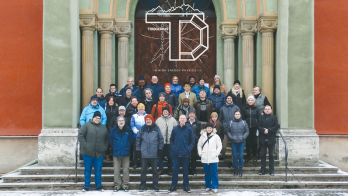
Beyond the Standard Model of particle physics (SM), crucial open questions remain such as the nature of dark matter, the overabundance of matter compared to antimatter in the universe, and also the mass scale of the scalar sector (what makes the Higgs boson so light?). Theorists have extended the SM with new symmetries or forces that address these questions, and many such extensions predict new resonances that can decay into a pair of bosons (diboson), for example: VV, Vh, Vγ and γγ, where V stands for a weak boson (W and Z), h for the Higgs boson, and γ is a photon.
The ATLAS collaboration has a broad search programme for diboson resonances, and the most recent results using 36 fb–1 of proton–proton collision data at the LHC taken at a centre-of-mass energy of 13 TeV in 2015 and 2016 have now been released. Six different final states characterised by different boson decay modes were considered in searches for a VV resonance: 4ℓ, ℓℓνν, ℓℓqq, ℓνqq, ννqq and qqqq, where ℓ, ν and q stand for charged leptons (electrons and muons), neutrinos and quarks, respectively. For the Vh resonance search, the dominant Higgs boson decay into a pair of b-quarks (branching fraction of 58%) was exploited together with four different V decays leading to ℓℓbb, ℓνbb, ννbb and qqbb final states. A Zγ resonance was sought in final states with two leptons and a photon.
A new resonance would appear as an excess (bump) over the smoothly distributed SM background in the invariant mass distribution reconstructed from the final-state particles. The left figure shows the observed WZ mass distribution in the qqqq channel together with simulations of some example signals. An important key to probe very high-mass signals is to identify high-momentum hadronically decaying V and h bosons. ATLAS developed a new technique to reconstruct the invariant mass of such bosons combining information from the calorimeters and the central tracking detectors. The resulting improved mass resolution for reconstructed V and h bosons increased the sensitivity to very heavy signals.
No evidence for a new resonance was observed in these searches, allowing ATLAS to set stringent exclusion limits. For example, a graviton signal predicted in a model with extra spatial dimensions was excluded up to masses of 4 TeV, while heavy weak-boson-like resonances (as predicted in composite Higgs boson models) decaying to WZ bosons are excluded for masses up to 3.3 TeV. Heavier Higgs partners can be excluded up to masses of about 350 GeV, assuming specific model parameters.





